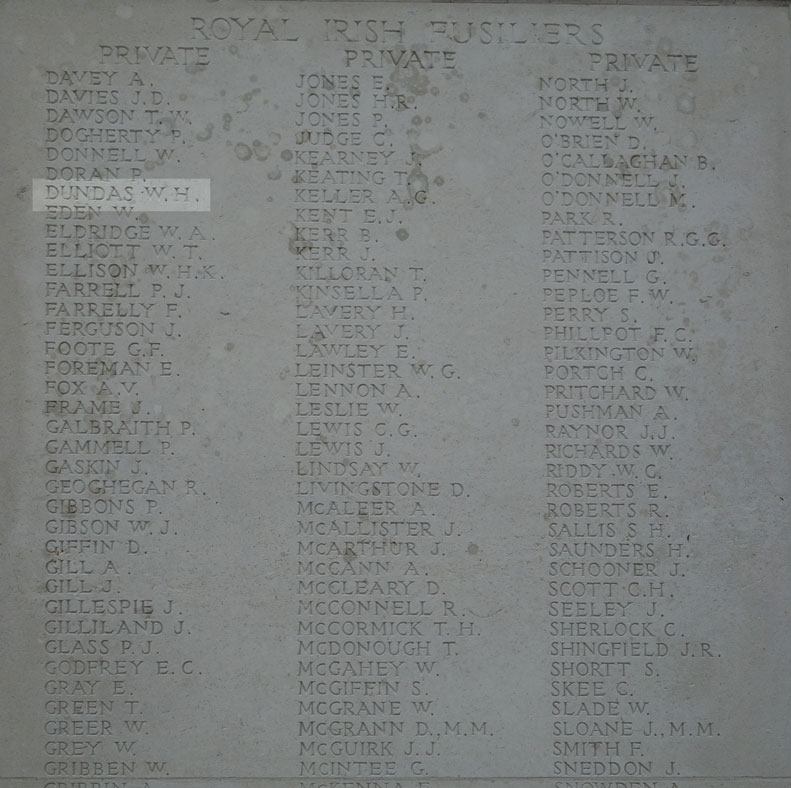![]() In memoriam
In memoriam ![]()
Private William Henry Dundas
William Henry Dundas was born at Drumcrow, Church Hill, County Fermanagh, the second of six children of farmer Edward Dundas and his wife Margaret (nee Johnston). His mother died when he was just 15 and by 1911 he was living with his father and four siblings on the family farm at Drumcrow West.
Dundas enlisted in the North Irish Horse at Ballyshannon on 2 October 1911 (No.620). He embarked for France on 20 August 1914 with C Squadron, seeing action on the retreat from Mons and advance to the Aisne. At this time he was incorrectly reported as having been killed. According to the Belfast News-Letter of 11 September:
Our Enniskillen correspondent writes:– Two deaths while on active service are reported in the "C" (Enniskillen) Squadron of the North Irish Horse – Trooper Dundas, Tabaugh, Derrygonnelly, and Trooper D. Wallace, Florencecourt. Both were troopers in the Enniskillen Horse, U.V.F.
In June 1916 C Squadron came together with F Squadron and the 6th (Inniskilling) Dragoons Service Squadron to form the 2nd North Irish Horse Regiment, serving as corps cavalry to X Corps until September 1917, when the regiment was dismounted and most of its men transferred to the infantry. After a brief period of training at the 36th (Ulster) Division's Infantry Base Depot at Harfleur, Dundas was transferred to the Royal Irish Fusiliers on 20 September and soon after was posted to the 9th (Service) Battalion – renamed the 9th (North Irish Horse) Battalion. He was issued regimental number 41399. He may have seen action with the battalion at the Battle of Cambrai in November and December 1917.
On 8 January 1918 Dundas was posted to the 1st Battalion, Royal Irish Fusiliers, where he joined C Company. He was reported as wounded following the German spring offensive in March and April 1918.
On 1 October 1918, having just returned from a fortnight's leave, Dundas joined the 1st Battalion’s attack on Hill 41 in Belgium. The battalion war diary describes the fighting as follows:
Orders were received that the Battalion was to attack Hill 41 at 6.15 a.m. from the West and if successful to exploit the advance on a line running N. of Coutrai. Time was very limited but a hasty moonlight reconnaissance was made and "C" & "D" Coys. ... were moved into an assembly position with "A" Coy. in support. The assault was covered by 2 batteries of Field Guns and Coys. moved forward to the attack at Zero hour. Heavy resistance was encountered on the Hill by M.G. and Trench Mortar fire but Twig Farm was captured with 23 prisoners and a line established N. & S. of this point. The support Coy. "A" Coy. ... was moved up to reinforce the attack, but casualties were so heavy that further progress could not be made. At 11.30 a.m. the enemy made a determined counter-attack on this line, but was driven off by our fire. Consolidation was proceeded with and a definite line was established. At 6.40 p.m. the enemy again counter-attacked after a very [...] artillery and M.G. preparation and endeavoured to re-capture Twig Farm. "C" Coy. were holding this post and succeeded in driving off the enemy after a severe fight in which many further casualties were sustained.
Private Dundas was one of the men killed that day. Having no known grave he is commemorated on Panel 141, Tyne Cot Memorial, Belgium.

Images Copyright © Phillip Tardif with all rights reserved as set out in this Use of Material policy.

